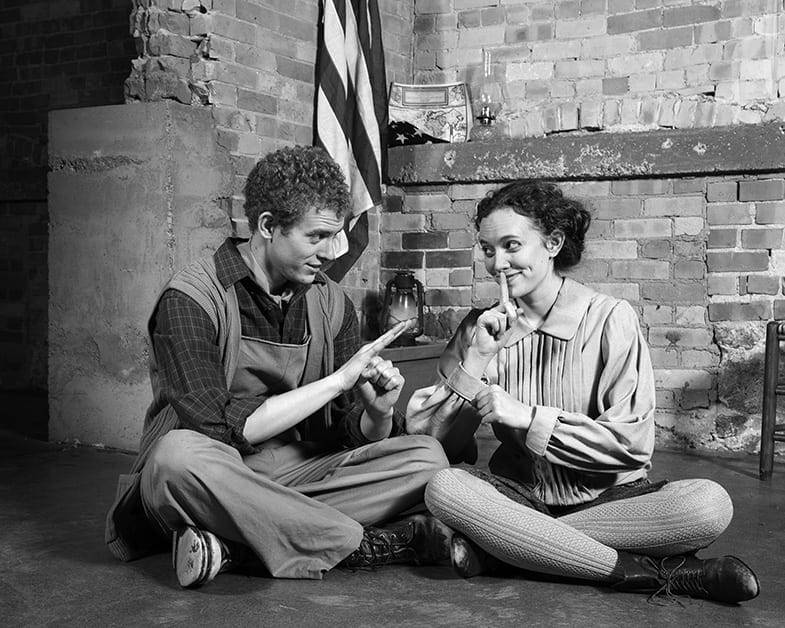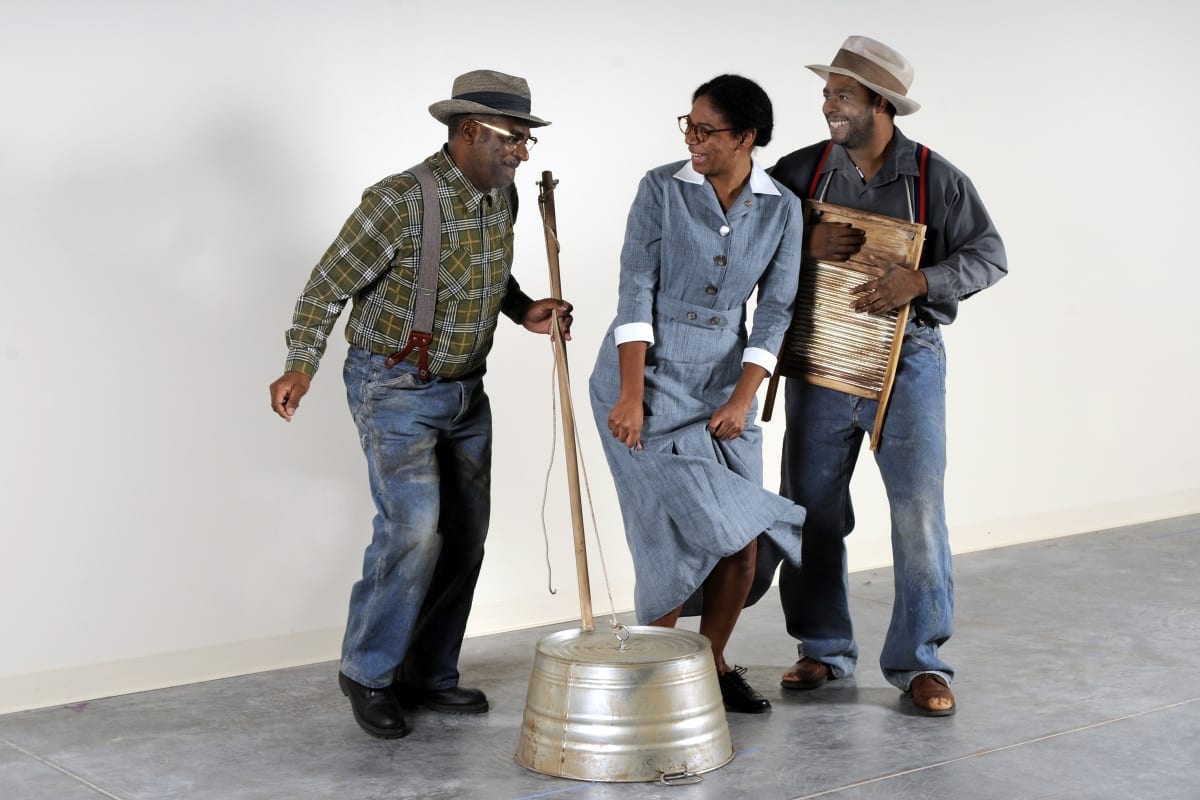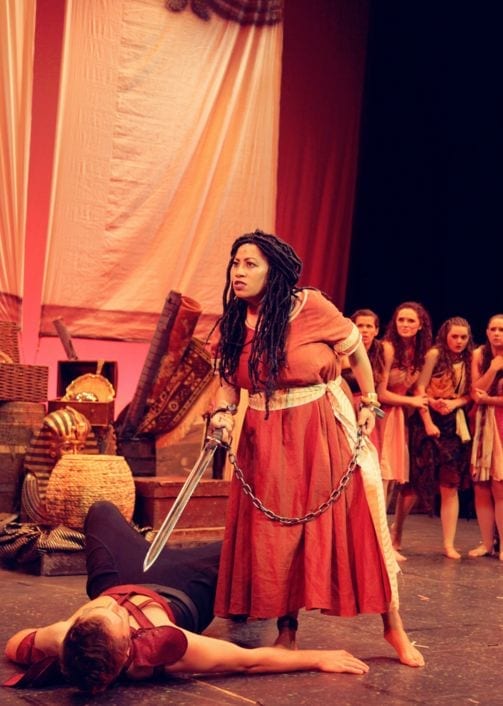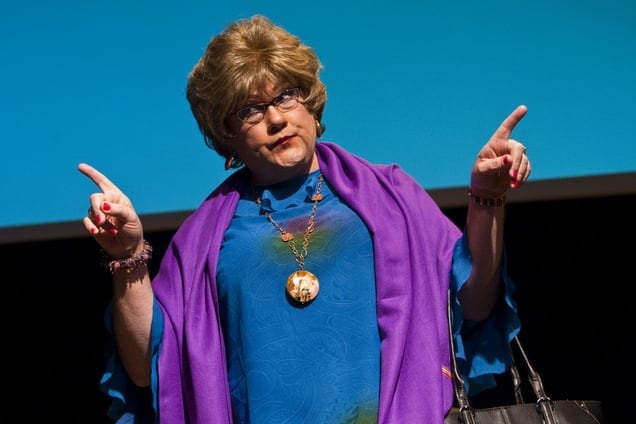PROVO — On the program for The Taste of Sunrise, there is a line from Susan Zeder‘s script, “Some things are so beautiful they don’t need sound.” No words that I can write can express the beauty of this BYU production of directed by Julia Ashworth.

Show closes March 26, 2016.
The Taste of Sunrise is a unique script that follows the story of Tuc, a young man whose bout with scarlet fever as an infant left him deaf. The play is performed in English and American Sign Language (ASL) and is filled with tenderness, laughter, and sorrow. It provides insight into how Deaf culture was in 1920’s and issues that the Deaf community faced then and now. This production teaches that people can become empowered by the abilities they have, in spite of their shortcomings, if we become at home with themselves.

Left to right: Abbie Craig as Maizie, Jake Earnest, as Jonas Tucker, Ben Featherstone as Tuc, and Katie Jarvis as Nell Hicks. Photo by Mark A. Philbrick.
This dual language production had to be challenging to direct, but Ashworth rose to the occasion. I deeply appreciated her decision to join with the local Deaf community in creating this production. Multiple cast members were Deaf or hard of hearing, and their personal experiences brought true power to this production. Every character was composed of two people, a voice and a signer. Characters who signed on stage had an actor portraying their voice from the aisles of the audience. Although I do not sign, I was able to understand everything that they actors presented to the audience. The friend who attended with me does sign and she was able see and understand everything being signed on stage. In addition, to efforts made with the blocking to have the interpreters visible, a middle section of the audience is set aside for deaf and hard of hearing audience members.
Tuc, played by Benjamin Featherstone, has very few oral lines. Earlier in the production, before Tuc learns to sign, his father (played by Jacob Earnest), is asked how he communicates with Tuc. He says that mostly Tuc just points and he, his father, just knows. The line indicates a very close connection between the young Tuc and his father. One of my favorite moments was when Jonas Tucker is telling his son, Tuc, a story. There are no words, only pantomiming, but the love and joy between the two is clear. My heart broke as I watched Jonas leave Tuc at school. Their relationship a key focus in the plot and Featherstone and Earnest were very real in their interactions.

Ben Featherstone as Tuc and Abbie Craig as Maizie. Photo by Mark Philbrick.
Another relationship that I loved was between Tuc and Maizie (played by Abbie Craig). Craig did a charming portrayal of Maizie, a lively young girl who works at Tuc’s school. Although Maizie can hear, she says she is deaf on the inside. She is kind to Tuc from the start, and as their relationship deepens she comes to rely on Tuc as a true friend. Tuc is the kindest, sweetest character I have seen on stage. Featherstone’s performance brought a joy and innocence to the role and forever endeared Tuc in my heart.
I feel that I must also address the performances of the interpreters. They were not merely standing on stage interpreting. They were tightly intertwined with the signing actors. I loved that the characters and the interpreters performed similar actions, but that they were still individual entities that didn’t follow each other action for action. Yet, their emotions were clearly aligned. A prime example of this was in the scene between Dr. Alexis Graham (played by Brittni Henretty) and Jonas Tucker. Dr. Graham was telling Jonas about the school for the Deaf where she works. The attitude that she portrayed was very clearly relayed be her signer, Christina Hernandez. Dr. Graham’s attitude was not one that would likely be shared by the Deaf and hard of hearing community, but Hernandez didn’t try to gloss over that attitude in her interpretation. She signed the lines with the same attitude Dr. Graham was expressing. Again, this shows that the interpreters were not just following the characters around, but that they were also acting performers on stage.

Part of the cast of The Taste of Sunrise. Photo by Mark Philbrick.
To me the interpreters were a part of character’s internal emotions. This was especially evident in the relationship between Maizie and Maizie’s Voice, performed by Brooklyn Downs. More than any other duo, these two were constantly switching roles of the oral speaker and the signer. I loved that there was acknowledgement between the two performers. Maizie’s Voice was often a gentle source of friendship and comfort, and also a part of Maizie that she wished to dismiss at times. Maizie is confused as to whether she belongs in the Deaf or the hearing world, as she is hearing but was raised by Deaf parents, and this is evident in her subtle interactions with her Voice.
In addition to the directing and the performances, the technical aspects of this production were also worthy of accolades. The unit set, designed by Travis Coyne, was simple in appearance and yet allowed for creating various locations. The aged wooden platforms had slates that were removed to reveal boxes of dirt that became the Tucker farm and surrounding land. The background of this set was a wooden frame of a house. A part of the frame is climbable and is used as a tree. The open gaps between the slats helped to showcase the lighting design, by Michael Kraczek, behind the house. Bare, round light bulbs, hung from above and were unnoticeable until they turned on to become the stars. Transitions between day and night were smoothly accomplish with the use of lights and sound (designed by Emilee Knell).
I also enjoyed the costume design by Mary Farahnakian and the makeup and hair designs by Kristen Watkins. The characters and their voices or signers were dressed similarly, but not identically. I liked this because it made it easy to pair but not confuse the duos. For example, Maizie and Maizie’s Voice wore different styles of clothes but sported matching hairstyles in the beginning. Tuc and Tuc’s Voice, wore similar overalls but in different color tones. At first it was a bit distracting that Tuc’s Voice was the only that wore nearly the same thing, but in light grays and off-whites. By the end of the show another character appears in similar colors. These two people are the only in this color palette, and after giving it some thought I’ve decided that it was a deliberate choice to help the audience subconsciously see the things and relationships that Tuc appears to have lost, but that he still holds inside.
I cannot recommend this production strongly enough. I laughed, I cried, and I cannot stop thinking about the experience that I had. I am hoping to take the opportunity to attend The Taste of Sunrise again. This production was written for audiences from middle school age and up, but audience members of six years old and older may attend and enjoy it. There is so much to learn and experience with the production. Please, please take the opportunity to attend before this show closes.






